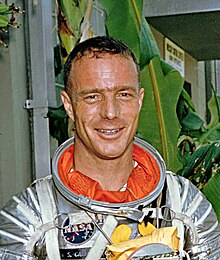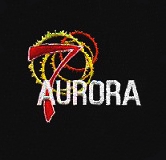Aurora 7
| Mission type | Test flight |
|---|---|
| Operator | NASA |
| Harvard designation | 1962 Tau 1 |
| SATCAT no. | 295 |
| Mission duration | 4 hours, 56 minutes, 5 seconds |
| Distance travelled | 122,344 kilometers (76,021 mi) |
| Orbits completed | 3 |
| Spacecraft properties | |
| Spacecraft | Mercury No.18 |
| Manufacturer | McDonnell Aircraft |
| Launch mass | 1,350.0 kilograms (2,976.2 lb) |
| Crew | |
| Crew size | 1 |
| Members | M. Scott Carpenter |
| Callsign | Aurora 7 |
| Start of mission | |
| Launch date | May 24, 1962, 12:45:16 UTC |
| Rocket | Atlas LV-3B 107-D |
| Launch site | Cape Canaveral LC-14 |
| End of mission | |
| Recovered by | USS Intrepid (CV-11) |
| Landing date | May 24, 1962, 17:41:21 UTC |
| Orbital parameters | |
| Reference system | Geocentric |
| Regime | Low Earth orbit |
| Perigee | 154 kilometers (83 nmi) |
| Apogee | 259 kilometers (140 nmi) |
| Inclination | 32.5 degrees |
| Period | 88.63 minutes |
| Epoch | May 24, 1962 |
 Malcolm Scott Carpenter
Project Mercury
Manned missions |
|
Mercury-Atlas 7, launched May 24, 1962, was the fourth flight of Project Mercury, the first manned space program of the United States. The Mercury spacecraft, named Aurora 7, made three Earth orbits, piloted by astronaut Scott Carpenter. He was the sixth human and the fourth American in space.
A targeting error during reentry took the spacecraft 250 miles (about 400 km) off-course, delaying recovery of Carpenter and the spacecraft. The mission used Mercury spacecraft No. 18 and Atlas launch vehicle No. 107-D.
The original prime crew for Mercury Atlas-7 was to have been Deke Slayton, with Schirra as his back-up. However Slayton was removed from all flight crew availability after the discovery of cardiac arrhythmia during a training run in the g-loading centrifuge. Slayton had chosen the name Delta 7 for the spacecraft, as this would have been the fourth manned flight and Delta (Δ) is the fourth letter in the Greek alphabet. Instead of using Schirra who was backup, it was decided to give the mission to Carpenter, who was the backup crew for Mercury-Atlas 6, had trained with John Glenn, and was considered the best prepared astronaut. When Carpenter was given the mission, he renamed it Aurora 7 for the open sky and the dawn, symbolizing the dawn of the new age. The number Seven was also chosen for the Mercury 7 astronauts. In addition, Carpenter's home address in his childhood was the corner of Aurora and Seventh Avenues in Boulder, Colorado.
Mercury spacecraft No. 18 was delivered to Cape Canaveral, Florida on November 15, 1961. While under checkout, the crew changed the periscope and also worked on the drogue parachute, to prevent it from firing prematurely as happened during the previous flight. In addition, a device known as a [446] "low-level commutator" was added, to measure the temperature around the capsule, recording temperature data from 28 positions on the spacecraft.
The Atlas vehicle 107D was rolled out of the Convair factory in San Diego, California on February 25, 1962. It was delivered to Cape Canaveral on March 6, 1962.
...
Wikipedia

